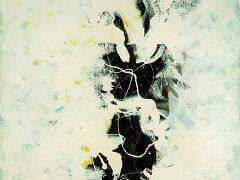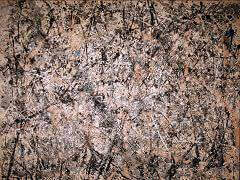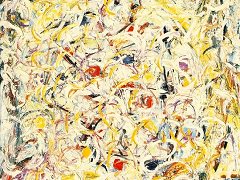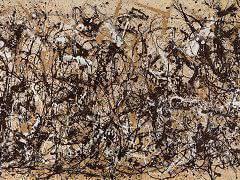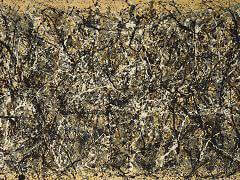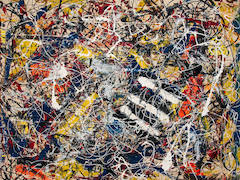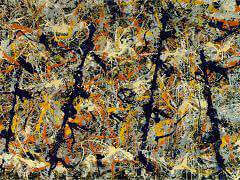Silver Over Black, White, Yellow, and Red , 1948 by Jackson Pollock
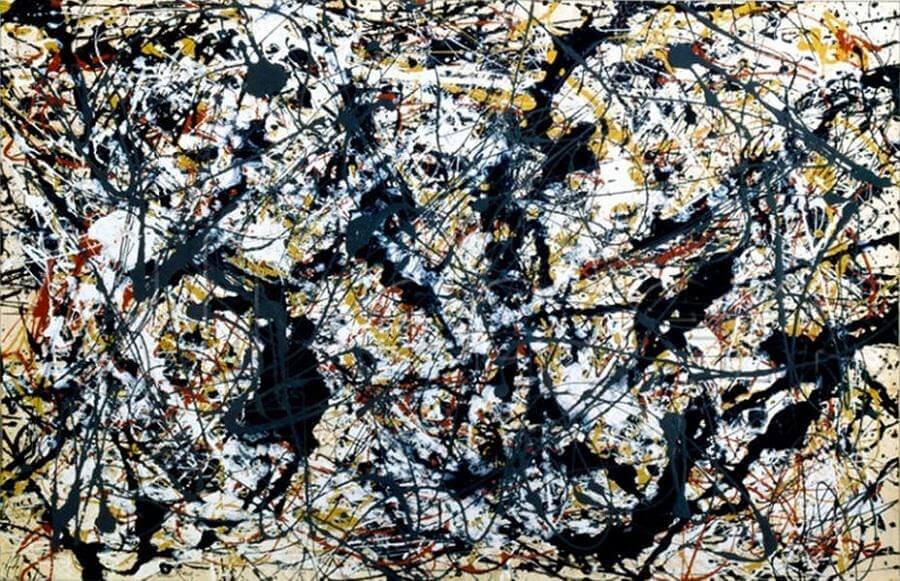
Pollock is most famous for his pouring technique and for painting his large canvases on the floor using heavily loaded brushes, sticks and turkey-basters to disperse the paint. Silver Over Black, White, Yellow, and Red,
1948 will clarify his methods. The surface consists of poured lines and small drops of paint on commercially dyed dark red fabric. The sequence of colours is as follows: thin grey and white lines, a row of bold black curves, an
overall intertwining of white and finally delicate pourings and touches of yellow, silver, scarlet and Indian red. Oil from the larger concentrations of black and white paint bled into the porous fabric, creating shadow-like areas
of a darker red. Pollock exploited this by carefully placing drops of Indian red paint, the same colour as the fabric, within these darker areas, creating a repoussoir effect that gives a lively dimensionality to what would
otherwise have appeared a drab mistake. Pollock was not arbitrarily 'dripping' paint but was concerned about, and carefully controlling, his painterly effects, despite the implications of the idea of Action painting. Elements that
soaked through appear there as if white were under black but appear on the front with the white on top, showing that Pollock filled in parts of the white lines so the overall aesthetic balance of lights and darks would, as he
liked to say, 'work.
The vertical black elements of the composition all feel as if the hand had applied them from left to right. Looking at the predominant white elements, a certain tension is discernible. The problem posed by visual instinct is
solved by recognizing that the whites were mostly set down from the other edge of the canvas. For Pollock, painting on the floor like a North American Indian sand painter, it was a matter of working along both of its long sides.
When the painting is reversed it is apparent that the whites flow as freely and logically as the blacks. One of the hallmarks of most of Pollock's large-scale work is that the major design elements flow from left to right, as if
written out. The left edge of the work, whichever side Pollock is working from, always begins with an elegant pirouette of paint, which then dances across the length of the canvas, until it reaches the terminal right edge, where
a suddenly stymied form signifies the artist's frustration that subjective infinity is limited by the objective length of his ground. This was typical of his way of thinking, akin to the wildness of nature.
The details of Pollock's style and facture, whether in major canvases or in his drawings and mixed-media works, all seem to derive from limitations of education and experience. In many ways his work was a closed system that re-assimilated itself until its energy dissipated. Yet his paintings and personality have entered modern mythology by virtue of a heroism of character that transcends both tradition and tragedy.



